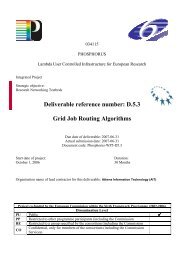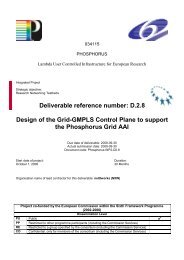D5.9: Extended Simulation Environment - Phosphorus
D5.9: Extended Simulation Environment - Phosphorus
D5.9: Extended Simulation Environment - Phosphorus
You also want an ePaper? Increase the reach of your titles
YUMPU automatically turns print PDFs into web optimized ePapers that Google loves.
D5.6 - <strong>Extended</strong> <strong>Simulation</strong> <strong>Environment</strong><br />
2.1 NS-2 basic characteristics<br />
NS-2 is a discrete event simulator targeting networking research in general. NS-2 provides substantial support<br />
for simulation of TCP, routing and multicast protocols over wired and wireless (local and satellite) networks.<br />
The code implementing the protocol models as well as the simulation engine (for the simulation of event<br />
scheduling, etc.) is C++, while an OTcl (short for MIT Object Tcl) simulation user interface is provided. The user<br />
describes a network topology by writing OTcl scripts, and then the main NS program simulates that topology<br />
with the specified parameters. In addition to the simulation program, NS-2 provides a number of tools for<br />
creating topologies and random traffic patterns. We extended the NS-2 code base to develop new algorithms<br />
and characteristics.<br />
2.2 GridNs module: Grid and Data Consolidation related<br />
extensions to NS-2<br />
In order to add Grid related characteristics to the NS-2 simulator, we implemented the gridNs module. In this<br />
module we also implemented the various Data Consolidation and fault tolerance techniques/algorithms<br />
previously investigated in [2] and [3]. In particular the gridNs module consists of the following files:<br />
cpp\DC_agent.cc and cpp\DC_agent.h: This C++ class implements a computational and storage Grid<br />
resource.<br />
cpp\DC_replication_table.cc and cpp\DC_replication_table.h: This C++ class implements the<br />
structure of a resource where datasets are stored.<br />
cpp\DC_scheduler.cc and cpp\DC_scheduler.h: This C++ class implements the Grid scheduler and<br />
the DC algorithms.<br />
cpp\task_struct.cc and cpp\task_struct.h: This C++ class implements a Grid job that has both<br />
communication and computation requirements.<br />
cpp\DC_hdr.h: This C++ class implements the DC specific data packet header.<br />
cpp\DC_graph.cc and cpp\DC_graph.h: This C++ class implements the topology graph. It is used by<br />
a number of DC algorithms in order to select the DC and the data replicas sites. In this class we used<br />
the Boost library‟s [Boost] Minimum Spanning Tree algorithms.<br />
cpp\stat_collector_dc.cc and cpp\stat_collector_dc.h: This C++ class is used for collecting<br />
statistics.<br />
tcl\lib\ns-dc-defaults.tcl: This tcl file contains the default values for a number of variables.<br />
tcl\lib\ns-dc-lib.tcl: This tcl file contains a number of functions used by the tcl interface in order to<br />
create a Grid topology.<br />
tcl\example\experiment.tcl: Through this tcl file the parameters and characteristics of an experiment<br />
are set up, such as the Grid topology, the characteristics of the links and the resources, the<br />
requirements (computational and communicational) of the jobs generated and other.<br />
Figure 1 shows the workflow of the gridNs module, both in OTcl and in C++ level.<br />
Project:<br />
<strong>Phosphorus</strong><br />
Deliverable Number: <br />
Date of Issue: 2009-03-31<br />
EC Contract No.: 034115<br />
Document Code: <br />
10






